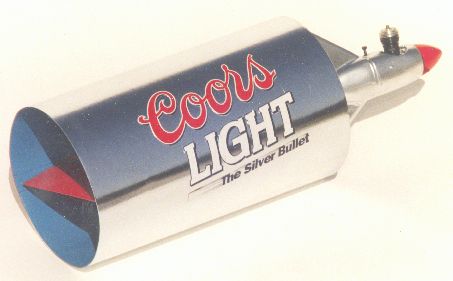The Flying Can Blimp
If you never land, why carry the weight of landing gear??
Instead of having to erect a special docking mast at each show location, we envision a special truck that would extend a docking tower and stabilizing out-riggers (not shown here, but needed) for stability. We have no landing gear weight either, because once it got airborne we never intended to land it again! It docks into the truck mast with an aircraft carrier type arresting gear (at 1 or 2 MPH, not 200 MPH! also not shown). The pilot gets in and out using a helicopter winch seat harness - no steps or ladders means no weight. Same for refueling - it will be pumped from the docking mast! The cutaway shows that the craft could be made from a series of inflatable toroids (donuts and innertubes). Toroids are stable when inflated, whereas inflating a cube shaped object results in bulged surfaces. The outer decorative skin just stretches over the toroids and would not contain any helium. Changing the toroids crossection diameters can yield a reasonable airfoil shape for the tube's crossection which will help reduce power required.

And before the giant docile Flying Can Blimp, we were working on actual rigid Flying Can type manned aircraft. The above is one U-Control proof-of-concept demo model that flies fine. We made all sorts of proof-of-concept advertising aircraft to represent actual products. We still have the Flying Rice Krispies Box, the Flying Flat Bill Board, and the DHL Van (the Van was also tubular - no grill, front windshield, or rear doors - only looked right from the side).
You may ask why did these ideas get put aside?? Well - we made this 8 inch diameter foam tubular body for one of the powered models that was so ugly that it got put aside. A few weeks later,I duct taped a few bolts on its front for kicks and tossed it. Was surprised when it glided maybe 30 feet or so. Interesting, but since it was so ugly it got put away for a couple of more weeks. Then, a friend who was trying to help us get funding was visiting and I just happened to toss it for him. He asked if could we make a small one - the size of a Pepsi Can, so he could just toss it at his presentations. To see a proposed flying can fly would obviously eliminate all doubt as to whether or not these engineers (us) could even make a round thingie fly? I responded that I had no clue if a small one would even work, but would be happy to make something up and find out. Well, the very first one was gliding a bit more than 50 feet. Whoa - this could be a product itself! My brilliant partner, Bob Kubinski, came back the next day and recommended we make it just a tad larger - so the pop cans could be slipped into it and we would have a Can Cooler that was also a cool flying toy! BINGO! That was it - wonderful - off to my patent guy that afternoon! Bob and I continued development. Number 87 flew awesome and was a version that could be economically produced. It became the production concept. The big blimp got put aside when CanoSOARus was born! Life is what happens to you while you are busy making other plans!!
We also found out there have been flying tubular toys patented as far back as 1919 with many others in between. Our first patent application was garbage. Our second attorney figured out what we actually had that was really unique and different from all the earlier inventions. Now we have a patent based on physical principals instead of some mechanical embodiment that can easily be changed or improved upon.